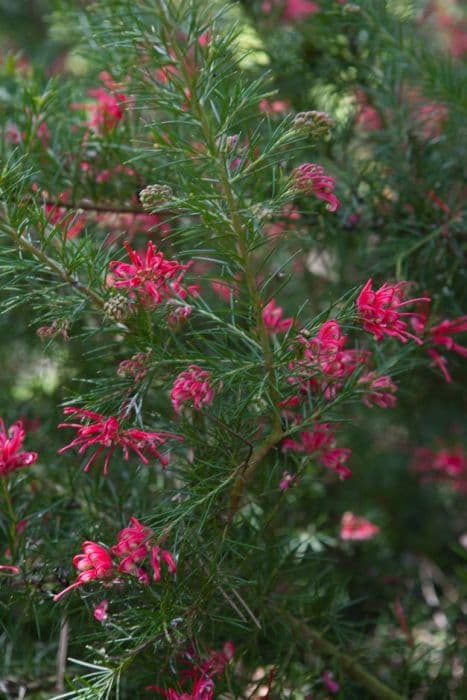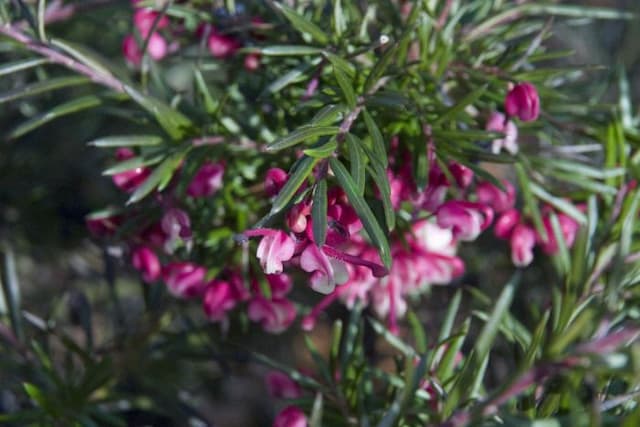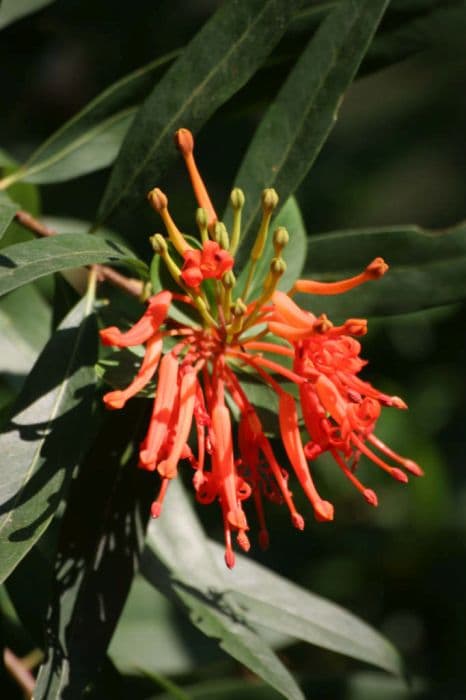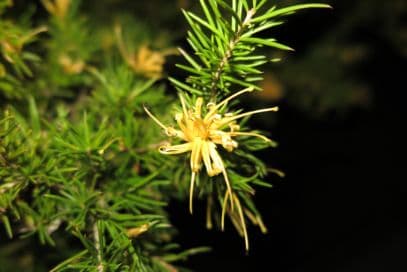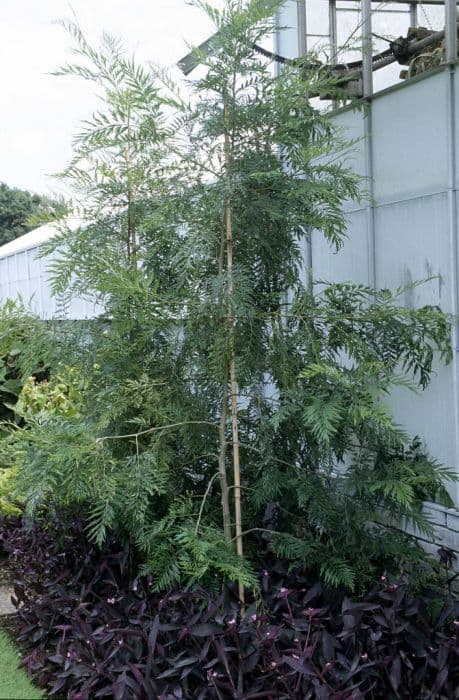Chilean Firebush Embothrium coccineum (Lanceolatum Group) 'ñorquinco'

ABOUT
The Chilean firetree, which is commonly known as 'ñorquinco', exhibits a dazzling display of fiery red or orange flowers that are sure to catch the eye. This plant is characterized by its slender, lance-shaped leaves which provide a lush backdrop for the showy blooms. The leaves are typically a deep, glossy green, offering a remarkable contrast against the brightly colored flowers. During the blooming period, the 'ñorquinco' becomes particularly striking, with the flowers grouped in clusters forming a remarkable and vibrant spectacle. The warmth of the colors of its blooms resembles that of a glowing flame, hence the common name Chilean firetree. This plant is not only known for its beauty but also for its ability to attract pollinators such as hummingbirds who are drawn to the tubular flowers in search of nectar. The overall structure of the 'ñorquinco' presents a somewhat umbrella-like canopy due to its spreading branches. This creates a natural and elegant shape, making it an attractive choice for gardeners looking to introduce a splash of warm color to the landscape.
About this plant
 Names
NamesFamily
Proteaceae.
Synonyms
Chilean Fire Bush, Chilean Flame Flower, Fire Bush, Flame Flower, Notro, Ciruelillo.
Common names
Embothrium coccineum var. lanceolatum, Embothrium lanceolatum.
 Toxicity
ToxicityTo humans
The most common common name for Embothrium coccineum is Chilean firetree. Typically, there is no broad documentation of Chilean firetree being toxic to humans. However, as with many plants, individual sensitivities can vary, and it's always prudent to handle unknown plants with care and avoid ingestion unless they are known to be safe. If someone were to ingest part of the Chilean firetree and experience symptoms, it would be best to consult with a medical professional.
To pets
The Chilean firetree is not widely recognized as a toxic plant to pets. Nevertheless, it is always advisable to prevent pets from consuming plants not intended for their consumption, as individual reactions can vary. If a pet displays signs of illness after ingesting this plant, contact a veterinarian.
 Characteristics
CharacteristicsLife cycle
Perennials
Foliage type
Evergreen
Color of leaves
Green
Flower color
Red
Height
10-15 feet (3-4.5 meters)
Spread
6-10 feet (1.8-3 meters)
Plant type
Tree
Hardiness zones
9
Native area
Chile Argentina
Benefits
 General Benefits
General Benefits- Ornamental Value: Chilean Firetree, as Embothrium coccineum is commonly known, offers vibrant red or orange flowers that add striking visual appeal to gardens and landscapes.
- Attracts Wildlife: The vivid blossoms attract pollinators such as bees and hummingbirds, promoting biodiversity.
- Low Maintenance: Once established, the Chilean Firetree is relatively low maintenance, requiring minimal care beyond occasional watering and pruning.
- Drought Tolerance: The species exhibits some level of drought tolerance, making it suitable for xeriscaping and gardens in drier climates.
- Seasonal Interest: With its fiery blooms, the Chilean Firetree offers seasonal interest, particularly in spring and early summer when flowers are most abundant.
- Adaptive Growth: It is capable of adapting to a range of soil types, although it prefers well-drained, slightly acidic soils.
- Cultural Significance: In its native range, the Chilean Firetree has cultural value and is often planted in public spaces and as part of traditional celebrations.
 Medical Properties
Medical PropertiesThis plant is not used for medical purposes.
 Air-purifying Qualities
Air-purifying QualitiesThis plant is not specifically known for air purifying qualities.
 Other Uses
Other Uses- Chilean firebush can be used as a natural dye due to the pigments in its flowers and bark, often resulting in earthy tones.
- The blooming branches of Chilean firebush can be cut and used in floral arrangements for their vibrant color and unique appearance.
- In woodworking, the wood of the Chilean firebush can be utilized for crafting small objects, owing to its hard, dense nature.
- The nectar-rich flowers make it a suitable plant for creating habitat gardens designed to attract and support pollinators like hummingbirds and bees.
- Chilean firebush can be planted as part of a windbreak or shelterbelt arrangement for protection against strong winds.
- The trees can be strategically planted to combat soil erosion on slopes due to their sturdy root system.
- It can serve as an ornamental hedge when pruned regularly, creating a striking natural barrier that blooms vividly.
- Chilean firebush can be used in educational settings, such as botanical gardens, to teach about plant adaptation to fire-prone environments.
- The plant can also be part of bioclimatic architecture designs, incorporated into landscapes to enhance the microclimate around buildings.
- Used as an overwintering haven for beneficial insects, Chilean firebush's thick foliage provides shelter during the colder months.
Interesting Facts
 Feng Shui
Feng ShuiThe Chilean firetree is not used in Feng Shui practice.
 Zodiac Sign Compitability
Zodiac Sign CompitabilityThe Chilean firetree is not used in astrology practice.
 Plant Symbolism
Plant Symbolism- Fiery Passion - The bright red or orange tubular flowers of the Chilean Firetree symbolize intense feelings and emotions, reminiscent of a fire's blaze.
- Unique Beauty - With its striking appearance and unique flower structure, the Chilean Firetree represents beauty that stands out from the crowd, embodying individuality and distinctiveness.
- Vitality and Energy - The vibrant colors and vigorous growth of the Chilean Firetree are often associated with liveliness and high energy, representing an enthusiasm for life.
- Rarity and Exclusiveness - Since the Chilean Firetree is indigenous to South America and not commonly found in many other places, it can symbolize uniqueness or something that is treasured because it is rare.
- Transformation - The tree's dramatic change in appearance when it blooms can represent transformation, renewal, or a sudden emergence of consciousness.
 Water
WaterThe Chilean Firetree, also known by the common name Chilean Flame Tree, should be watered regularly to maintain consistently moist soil, particularly during its active growing season in the spring and summer. Allow the top inch of soil to dry out before watering again. Depending on the climate and weather conditions, this could mean watering once every one to two weeks, using about 1-2 gallons of water for medium-sized trees. In hotter, drier conditions, more frequent watering may be necessary. Reduce watering in the fall and further in winter when the plant's growth slows down.
 Light
LightThe Chilean Flame Tree thrives best in full sun to partial shade conditions. Planting it in a spot where it receives at least six hours of direct sunlight will encourage the best flowering and growth performance. However, in very hot climates, providing some afternoon shade can help protect the tree from intense heat stress.
 Temperature
TemperatureThe Chilean Flame Tree can tolerate a range of temperatures but prefers the cooler temperatures found in its native habitat. It can survive temperatures down to about 20 degrees Fahrenheit, albeit with potential damage to foliage, and can handle up to about 90 degrees Fahrenheit without severe stress. However, it thrives most ideally in temperate regions with temperatures consistently between 50 and 75 degrees Fahrenheit.
 Pruning
PruningThe Chilean Flame Tree should be pruned to remove dead or damaged wood and to shape the tree as desired. It’s best to prune in late winter or early spring before new growth begins. Pruning at this time allows for a quick recovery and less stress on the tree. Additionally, thinning out crowded branches can improve air circulation and sunlight penetration to the interior of the canopy, which is beneficial for overall plant health.
 Cleaning
CleaningAs needed
 Soil
SoilThe Chilean Firetree prefers well-draining, fertile soil with a slightly acidic to neutral pH between 5.5 and 7.0. A mix containing peat, sand, and loam in equal parts is ideal to support its growth.
 Repotting
RepottingChilean Firetrees, being large shrubs or trees, are not commonly repotted. Instead, they should be planted in a location where they can grow without being moved. Young plants can be repotted every 2-3 years to encourage growth.
 Humidity & Misting
Humidity & MistingThe Chilean Firetree thrives in moderate to high humidity levels. While it can tolerate some dryness, consistent humidity is beneficial, especially during flowering periods.
 Suitable locations
Suitable locationsIndoor
Provide bright light, cool temperatures, and monitor humidity.
Outdoor
Plant in sun, protect from strong winds, ensure well-draining soil.
Hardiness zone
8-10 USDA
 Life cycle
Life cycleThe Chilean firetree, commonly known as 'ñorquinco,' begins its life cycle with seed germination, which occurs in well-drained soil and requires exposure to sunlight and moisture. As a seedling, it rapidly develops a root system and foliage, preferring cooler temperatures and tolerating some frost. The juvenile phase is characterized by fast growth and the development of its lance-shaped leaves and woody stems. Reaching maturity, the Chilean firetree produces vibrant red, tubular flowers that are pollinated by birds and insects, mainly in spring and early summer. Following pollination, the plant develops fruit capsules containing numerous small seeds that get dispersed by wind or gravity. The firetree's life span can extend many years, during which it may undergo cycles of flowering and seed production, often thriving in areas affected by wildfires due to its adaptability and resilience.
 Propogation
PropogationPropogation time
Spring to early summer
Propogation: The Chilean Firetree, or Embothrium coccineum, commonly propagated from seed, offers a successful method when timed with the end of the plant’s dormancy period, typically around spring. The most popular method of propagation is seed sowing, where the seeds, after being harvested in their ripe state, need to be pre-treated to break dormancy. This can be achieved through stratification, which involves mixing the seeds with a moist medium such as sand or peat moss and refrigerating them for approximately 4 to 6 weeks. After stratification, the seeds are sown in pots or flats filled with a well-draining soil mix, just lightly covered by soil, and then kept at a warm temperature around 55 to 64 degrees Fahrenheit (13 to 18 degrees Celsius). They require bright, indirect light to germinate, a process that could take several weeks, during which the soil should be kept consistently moist but not overly wet to prevent any rot. Once the seedlings have grown to an adequate size and have developed true leaves, they can be transplanted to individual pots or directly outdoors if the climate conditions are suitable.

